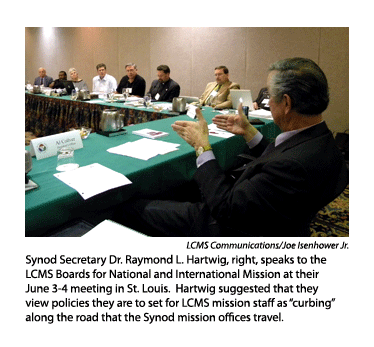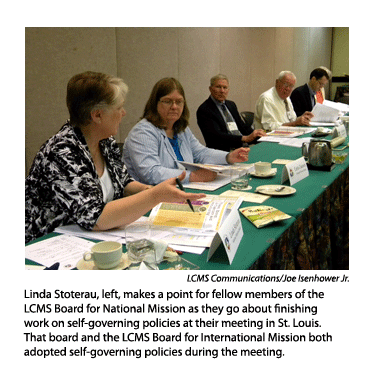By Joe Isenhower Jr.
ST. LOUIS — The LCMS Board for National Mission (BNM) and Board for International Mission (BIM), meeting here June 3-4, individually approved their self-governing policies and reviewed with Synod President Dr. Matthew C. Harrison h is work on a theological foundation preface to the policy manual they are developing for the church body’s two new mission offices.
is work on a theological foundation preface to the policy manual they are developing for the church body’s two new mission offices.
Also during the meeting, the BIM issued 17 solemn calls and appointments for LCMS career missionaries, international educators and “Globally Engaged in Outreach” missionaries. The boards also heard presentations from Synod Secretary Dr. Raymond L. Hartwig and David L. Strand, who heads the LCMS communications staff, as well as from other Synod staff for whom the boards are developing policy.
This was the fourth meeting of the two 11-member boards since they were formed by 2010 Synod convention delegates, who elected board members after adopting Resolution 8-08A. That resolution called for restructuring the national Synod by reducing the previous seven staffed Synod program boards and a number of commissions to the two new policy boards.
The boards will continue to develop policies for the Synod offices of International and National Mission.
A policy-development timetable for review at this meeting suggests that the boards’ initial policies for those offices be drafted over the next several meetings and finalized by September 2012. After that work is completed, the mission boards will conduct an annual review of their policies.
Harrison on preface
As the June meeting got under way, Harrison reported that he is continuing to work on the theological foundation document that the boards asked him to develop and is planned to be the preface of the policy manual.
For that assignment, the boards in February passed a resolution stating, “We will use the Board for Mission Services 2000 ‘theological preface’ (Witness) and LCMS World Relief and Human Care’s ‘Theology for Mercy’ (Mercy) as foundational documents (for the drafting of the preface). We will also give due consideration to the theology of our Life Together, all so that the Synod might experience unity and blessing in its work of mission together.”
“Witness, Mercy, Life Together” is the Synod president’s overall emphasis. The offices for national and international mission, for which the boards are drafting policy, also are being organized around those emphases.
“The goal [for the theological foundation preface] is an adequate description of a theology for Witness, Mercy and Life Together as the church’s mission,” Harrison pointed out in a note to the board, a ccompanying the draft of his work so far on the theological preface.
ccompanying the draft of his work so far on the theological preface.
“This is a work in progress,” Harrison’s note continued. “It is my desire that this preface will be a document that we can ultimately use in presenting a fulsome theological basis for the church’s work.”
“This is the piece we need to go through when there are questions,” Harrison told the boards. He added that when finished, it “should be worthy of study throughout the Synod.”
In round-robin format, board members individually expressed their appreciation for Harrison’s work on the document and made a number of suggestions as he continues to draft the document.
Harrison encouraged board members to send him comments about the document via email.
“This document will be put before you for concurrence,” Harrison told them.
The completed theological foundation preface will be shared with the Synod at-large when it is complete.
Policy as ‘curbing’
Synod Secretary Dr. Raymond L. Hartwig suggested in a presentation for the June meeting that the two boards consider an analogy used by Barbara A. Below, assistant to Harrison and staff liaison for the mission boards, that they view their policies as “curbing” on the road that the Synod’s mission offices travel.
“Your job is to define the boundaries, parameters and principles for the [mission] offices,” Hartwig said.
“The mission offices will move things forward,” Hartwig told the boards, adding that the Synod president and the chief mission officer (CMO – a key staff position also established by the 2010 LCMS convention to supervise mission staff and others, on behalf of the president) function like the star-five-one-one calls, should the boards see concerns along the way that need to be addressed.”
Hartwig also encouraged the boards to view current policies as they go about developing policy.
“Like roads, policies need to always be under construction,” said BIM member Rev. Michael Lange.
Below then offered examples of boundaries, parameters and principles – “what the subjects are that you might want to write policy on,” she explained.
Rev. John Temple, a BIM member, asked how to develop policy in relation to the Synod budget set by the LCMS Board of Directors.
Hartwig advised staying in close contact with staff “to see what can be afforded,” in consultation with the president and the CMO.
Noting that a Synod bylaw stipulates that the BNM relates to districts, congregations and schools, First Vice-President Rev. Herbert C. Mueller Jr. asked if policies of the board could be binding for districts.
“The Board for National Mission writes policy for the Synod’s national mission office, not districts,” Hartwig said, to which Below added that the board would be “writing policy that coordinates with and supports district ministries — not about what districts do.”
Below also updated the boards on the progress of restructure for the Synod since the February meeting.
Earlier in the meeting, Harrison reported to the boards that “restructuring has gone extremely well.”
Input from staff
Strand described for the boards the makeup of Synod communications under the new structure — with communications functions of various departments coming together as one, “to avoid redundancy, waste and overlap.”
“I assure you that whatever communications needs your staff has and can afford, we’ll be there to deliver in high style,” he said.
On Saturday morning (June 4), the boards met separately.
During that session, the BIM heard a report from Rev. John Mehl, regional director for Asia for LCMS World Mission, on the Synod’s work in that region. At each of the next four meetings of the board, another of the five regions will be featured.
Dr. David C. Birner, associate executive director with LCMS World Mission, told Reporter via phone after the meeting that Mehl “was putting detail and explanation to our overall mission strategy of establishing sustainable church bodies that are equipped to proclaim the Gospel from generation to generation.”
Birner said that he also described for the board “that distinction of the LCMS’ international operations … for the past 60 to 70 years — that the work we do internationally results in establishing sustainable communities of believers that teach their young people, train their pastors, serve their communities and ultimately develop their own mission outreach to other countries. We walk with them in each one of those steps.”
LCMS World Mission also prepared for the boards’ docket a summary page for each of 90 countries in which it conducts work. Birner referred to that material as “a comprehensive snapshot of our global operations — including international projects and international missionaries. It gave the [BIM] a look at the overall snapshot of the LCMS international footprint,” he said.
For that same session, the BNM heard reports on several LCMS national ministries — from William Cochran for School Ministry, Rev. Mark Kiessling for Youth Ministry, Deaconess Dorothy Krans for Recognized Service Organizations, and Rev. Wayne Knollhoff for Stewardship Ministry.
After their presentations, members of the board asked each of those four individuals for input as the board goes about developing policies for the ministries they represent.
Working with districts
First Vice-President Mueller also went over the results of a “National Mission Board Questionnaire” that resulted after BNM Chairman Rev. Steven C. Briel asked him to conduct “an informal poll of the Council of Presidents regarding their thoughts on the work of national missions,” Mueller wrote in an introduction to those results.
He also wrote that all the district presidents’ comments from the questionnaire will be shared with all of [those presidents] and “are being considered by the [LCMS] president’s office.”
“Right now we are at the point where much more consultation with the [Council of Presidents] is needed and is being sought,” Mueller continues in the introduction.
He also noted that it was the intent of the Blue Ribbon Task Force on Synod Structure and Governance — whose recommendations led to a number of resolutions adopted by the 2010 Synod convention, including establishing the two mission boards — “that the details of what the staff at Synod does are driven by the needs of the congregations.”
Mueller indicated that is what the National Mission Conference planned for Sept. 20-22 in St. Louis “is all about … with regard to national missions.”
Invited to that conference are the COP, several district mission executives, the executive committee of the BNM and others representing Synod-related organizations involved in national mission work.
Posted June 22, 2011




